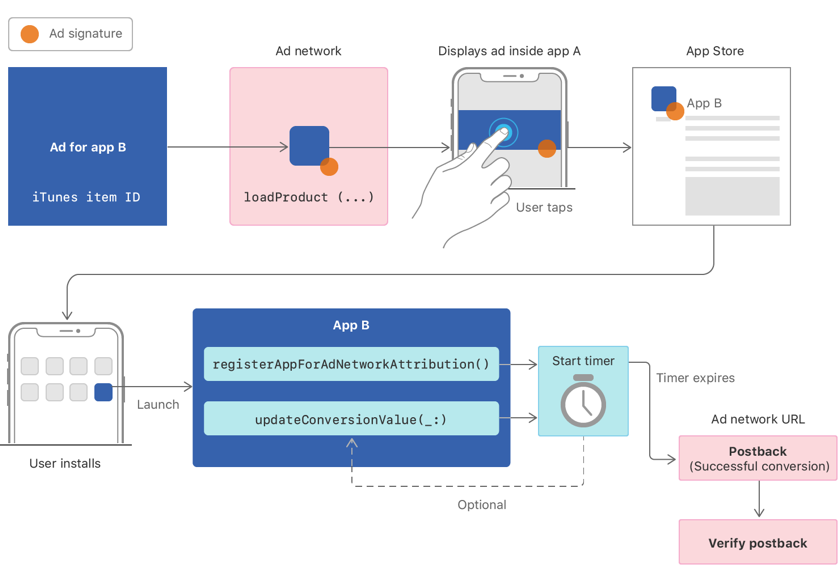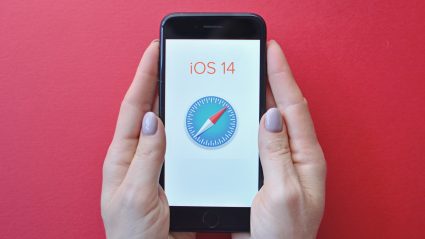While you’ve probably seen plenty of sensationalist headlines about the upcoming iOS 14 update from Apple (see: Safari now blocks Google Analytics on sites, new Privacy Report feature shows, which we already debunked), the truth is that much is still unknown about the update and it is likely to have a broad impact across the digital marketing ecosystem. Apple itself has just pushed the release until next year, which gives you more time to prepare for the changes.
We’ve put together this guide to make sure you have the information you need to prepare without inciting an unnecessary panic.
The Basics: What you need to know about the iOS 14 update
What is the IDFA?
IDFA refers to Apple’s “Identifier for Advertisers”. This is a persistent ID used by mobile devices running an Apple Operating system (iOS, iPadOS, tvOS), that, when shared with app developers, ad platforms, & mobile measurement providers (MMPs) powers the targeting & delivery of personalized advertising.
The IDFA also allows these platforms to enforce frequency capping, attribute app installs to ad platforms, and measure campaign performance. It’s similar to the Android Advertising Identifier (AAID) and commonly referred to as a Mobile Advertising Identifier (MAID). The IDFA is often used in tandem with cookies (which only exist in web browsers) to create a rich identity graph for ad targeting.
What’s actually changing in the iOS 14 update?
With the release of iOS 14, Apple is changing the way app developers can access the IDFA from an opt-out approach to an opt-in approach. Before the update, IDFAs were available for the majority of users; with iOS 14, we expect to see very few users choose to opt-in. Advertisers and platforms are likely to have access to a fraction of a % of the previous IDFAs available.
The iOS 14 update will essentially kill IDFA as a persistent identifier for users with iOS devices.
When will iOS 14 be released?
The specific date is still up in the air, but Apple has indicated the update is scheduled to occur in early 2021.
The Impact: How the iOS 14 update is likely to affect your digital marketing
Apple has provided very little information about the potential impact of the update (beyond a simplistic overview showcasing the user experience when they are asked if they want to opt-in), hence the sheer amount of speculation. But we’ve identified two major areas you’re likely to see dramatic changes immediately following the release of iOS 14:
App Install Tracking & Attribution
Apple has released the SKAd Network, which will not share any user, or device-level data with an advertiser. Simply put, it will allow Apple to control attribution passed back to Registered Ad Networks.
This is less than ideal because Apple has indicated that SKAd Network will:
- Only allow for click-based attribution.
- Provide conversions in batches with a latency between 24 – 48 hours. No date stamp parameter will be provided.
- Limit Campaign IDs to 100 per ad network.

How the SKAd Network will pass data back to ad platforms and MMPs (Source: Apple)
Additional limitations of the SKAd Network include:
- A single, fixed Attribution Lookback Window: There are no attribution lookback windows available (1D, 7D, 28D etc.), and all app conversions will use a 30-60 day click-through attribution window.
- No ID-based Demographic Breakdown: There will no longer be access to attributes such as age, or gender.
- Probabilistic Data: Some platforms will be using probabilistic data (compared to the majority currently using deterministic data), more on this in the platform recommendations section below.
- Deferred Deep Linking: This will no longer be supported due to the exclusive focus on last-click attribution.
It’s worth exploring how all of this might affect app developers and what possible solutions to these challenges might look like, but make sure to consider any recommendations with a grain of salt, since we don’t know exactly what the post-IDFA Apple ecosystem will look like (and probably won’t until at least October).
But one thing we do know is that the biggest impact will likely be on targeted advertising.
Advertising: Targeting, Personalization, Frequency Capping
It’s tough to pinpoint how reliant advertising platform identity graphs are on IDFAs. If Facebook’s announcement that they believe they will see Audience Network revenue cut in half is any indication, the update is likely to have a huge impact across advertising on the open web. Indeed, if we take the conservative view that 50% of mobile users have iOS & 50% have Android, the announcement indicates that Facebook believes there will be a complete loss of user-level targeting across the audience network for iOS.
It should be noted that Facebook will not be asking users to provide them with an IDFA at all, so even if a user wanted to opt-in, they won’t have that choice available to them.
But the most significant effects here will likely not be felt by Facebook, or any of the walled garden advertising solutions (Google Search, YouTube, etc.), as their in-platform user ID graphs will likely provide them more resilient audience targeting solutions.
The real impact will probably hit apps and programmatic placements across the open web the hardest. It’s not that advertising will stop: rather, it’s likely that we will see a decrease in targeting power and control that will ultimately create more inefficiencies (like not being able to control frequency capping) and poor ad personalization leading to negative user experiences. It remains to be seen how publishers will try to combat this, but it’s possible that they may just add on additional ad units to help recover revenue streams, to the detriment of users and advertisers alike.
Beyond those driving App Installs, the best way to prepare for this as an advertiser is to ensure you’re capturing user information whenever possible. Capturing emails will be crucial as their value is likely to increase as other IDs fall by the wayside.
The Plan: Platform recommendations for iOS 14 update
Last week, our team spoke with many of our platform partners and asked them to share their recommendations and resources for advertisers that may be impacted by this change. Please note that these recommendations are subject to change and we recommend reviewing their specific websites.
Essentially, all of the platforms are recommending that their clients ensure they’re using the most recent release of their specific SDKs to ensure they can capture the IDFA (following the permission requested flag). The nature of permission-based IDFA collection has created significant architectural changes, and using legacy SDKs will not allow for the collection of IDFA following the new protocols.
It should also be noted that all recommendations provided pertain ONLY to those advertisers running App Install campaigns via these platforms.
Mobile Measurement Platforms (MMPs)
If you’re using an MMP such as Kochava, AppsFlyer or Branch, you should follow their specific instructions:
- Kochava: Getting Prepared for iOS 14
- AppsFlyer:
- Branch:
- Singular: User acquisition in iOS 14: 24 questions answered
- Adjust: Getting your company ready for iOS 14
Our partners at Facebook have provided the following information about changes related to the SKAd network and what they recommend brands do to prepare:
- For ads reporting (Ads Manager, Ads Reporting, Insights API), there will be a number of changes for iOS 14 app install campaigns, which will rely on data from Apple’s SKAdNetwork (SKAN) API:
- The SKAN API will report back data aggregated at the campaign level. Reporting at the ad set, campaign, and account levels will match results returned by the SKAN API, while reporting at the ad level will be modeled based on aggregated data received from the SKAN API, unless there is only one ad for a given campaign.
- Demographic breakdowns will no longer be available
- The SKAN API will not provide support for attribution window breakdowns (1D, 7D, 28D).
- The SKAN API will not provide support for real-time reporting. Data will be reported back data with a randomized delay of up to three days.
- Cross-account reporting can only be done within the same account type, not across iOS14 and non-iOS14 accounts.
- A/B testing Mobile App Installs and post-install events from iOS 14 devices will be only available at campaign-level. There will be no impact to reporting for Android and iOS 13 campaigns.
- For managed Conversion Lift, self-serve Conversion Lift and Facebook Attribution, we will likely no longer be able to measure app Installs and app events from iOS14 devices. We will continue supporting measurement of app installs and app events from Android and iOS13 devices.
- For mobile measurement partners, Facebook will share SKAdNetwork data with MMPs, for advertisers that have given the MMP Business Manager permissions, via the Ad Insights API for all iOS14 mobile app install (MAI) campaigns. For advertisers utilizing the FB SDK, Facebook will support MAI and AEO. We are still exploring how to support advertisers that utilizes only the MMP SDK for other non-app-install iOS14 objectives (e.g. Traffic, Conversions, Product Catalog Sales), app event optimization, and value optimization. Reporting for Android and pre-iOS14 will remain as it is today.
Due to significant restrictions imposed by Apple’s SKAdNetwork API, for app install ads targeting iOS 14 users, we will operate with the following limitations starting in early September (which we may adjust with future releases):
- Ads Manager only (no support for Marketing API to create and edit campaigns targeting iOS 14)
- One iOS 14 ad account per app
- Nine published/created campaigns at any given time
- One ad set per campaign; but no limit on number of ads
We recommend reviewing all the ad accounts currently running app install campaigns for your app and consider consolidating budgets as you prepare to operate with one ad account for iOS 14 app install ads. If you typically create separate campaigns or ad sets per geo, consider grouping by geos, product category, language, ARPU (average revenue per user) to operate with a limited number of campaigns in September.
Finally, we recommend our partners take the following steps to prepare for iOS 14:
- Update to the latest version of the Audience Network SDK to support iOS 14. The new version of the Audience Network SDK will provide support for Apple’s SKAdNetwork API, which limits the data available to businesses for running and measuring campaigns. The iOS 14 release schedule has not yet been provided by Apple, but we will release the Audience Network SDK beforehand and will provide you with specific dates after Apple’s timeline is confirmed.
- Leverage non-IDFA match methods such as adopting Facebook Login.
Our partners at Google also explained the effect of the SKAd Network on conversion tracking and shared a checklist of recommended actions::
Once iOS 14 rolls out, any app or SDK that wants to access the IDFA would need the user’s explicit approval.
Google’s vision of raising the bar on privacy for users while also sustaining a healthy, ads-supported ecosystem also applies to apps.
- For apps, we recommend the Google Analytics for Firebase SDK as our 1P Measurement and Audience solution for apps
- For regulation like CCPA and GDPR, customers using this SDK may disable personalized advertising features for the appropriate users
We are exploring a variety of options to continue to meet advertiser needs on iOS campaigns. It’s possible that this may involve alterations to campaign features and functions, and we’ll have more to share in the coming weeks.
Impact for DV360 should look similar to impact on App Install campaigns for Google Ads
App Campaigns for Installs relies upon the iOS IDFA to measure conversions and to optimize campaign performance. As stated above, ACi will incorporate two additional approaches to optimize for iOS campaigns: conversion modeling and SKAdNetwork. We also recommend changes to campaign best practices:
Consolidating Campaigns
Advertisers should limit the total number of App campaigns to substantially fewer than 100 campaigns per app. This is to ensure that each campaign has sufficient conversion signals and to ensure compatibility with SKAdNetwork.
Conversion Volume, Bids or Bidding Strategy Changes
TBD – we may have additional campaign changes or new requirements for campaign minimums.
We do recommend that tROAS campaigns for iOS consider alternative bidding strategies at this time (such as tCPA) as it is unlikely that we will support tROAS for modeled conversions at launch.
Changes to Product Features
Several ACi campaign features may no longer be available for non-consented users on iOS. These may include, but are not limited to:
- Negative filtering
- Audience exclusions
- Deferred deep linking
iOS14 Preparation Checklist:
- Implement consent dialog: Encourage users to grant consent
- Implement or update the GA4F SDK: Update with the July 28 release with support for SKAdNetwork (AdNetworkAttribution)
- If needed, implement SKAdNetwork: If not implementing the GA4F SDK, implement SKAdNetwork separately
- Consolidate campaigns: Reduce the number of campaigns per app to significantly less than 100.
- Migrate off tROAS bidding: Use tCPA as a bidding strategy rather than tROAS for iOS.
- Make sure your app is updated for iOS14: Double check to make sure your app is ready for iOS14 on the App Store.
The Trade Desk
The Trade Desk recently announced a new framework known as Unified ID 2.0 along with a few additional identity innovations, including:
- Koa Identity Alliance: This feature automatically optimizes the use of multiple ID graphs, allowing advertisers to expand audience reach and insights across platforms.
- Koa for Cookieless: Coming in August, this new feature will use our AI to model an impression profile and then target similar users in cookieless environments.
- Cookieless Frequency Capping: Also coming in August, we will offer the ability to frequency cap campaigns in cookieless environments via the use of cohorts.
The Future: What comes next?
Identity Resolution Challenges
There are many platforms promising the next generation of identity resolution tools. Regardless of the technical sophistication on display, the lack of a foundational identifier is going to lead us down a probabilistic path. This is less than ideal for an industry founded on focusing on precise targeting of users at the right time.
It is likely that we will see many minor networks fade as they fail to compete with the identity graph strength of the entrenched players. Given Amazon’s growing programmatic arm, it wouldn’t be surprising to see them grow their market share and possibly acquire some of the smaller exchanges to better leverage their deep identity graph, spanning entertainment, gaming, commerce, smart speakers and more.
Cookies & Web Browser Tracking
While not specifically related to the IDFA changes, the attribution solution employed in the SKAd Network looks very similar to Apple’s “Private Click Measurement” proposal shared by John Wilander on the Webkit blog in May 2019. While this has yet to move into production, we believe this is the ultimate state for ITP and one that will likely arrive within the next 6 to 9 months.
Hold on tight: it’s going to be a bumpy ride as Apple looks to assert their market dominance over the digital marketing world.
Any time cookies are discussed, it’s important to make reference to Google’s Privacy Sandbox. This solution is likely to come to Google’s Chrome browser before the end of 2021, but its final state is still unknown (although there’s plenty of speculation about the existence of a secure, privacy-centric ID (similar to a MAID) for web-tracking).
Incremental Testing
Not a new concept (and one that comes with its own baggage) but incremental measurement is likely to become more of a focus for brands looking to understand the impact of their media. Of course, if the media is poorly targeted and hard to control, then this may not be very effective beyond the existing walled gardens of Google & Facebook.
Additional Reading:
- Clear Code | Apple’s Changes to IDFA in iOS 14: FAQs and the Impact on Mobile Advertising
- Apple | User Privacy & Data Use
- Ad Exchanger | IDFA Apocalypse: What We Know (And Don’t)







Responses